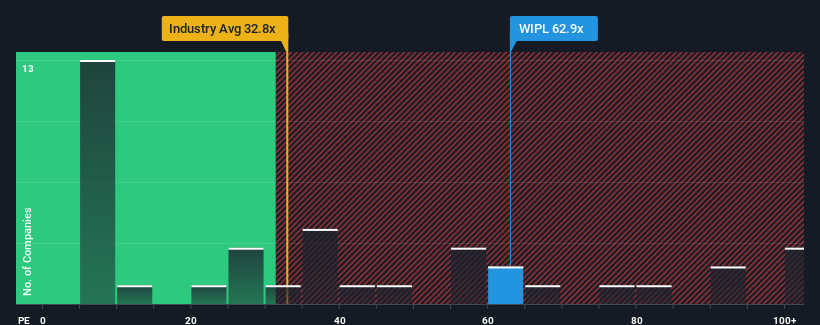- India
- /
- Paper and Forestry Products
- /
- NSEI:WIPL
Earnings Not Telling The Story For The Western India Plywoods Limited (NSE:WIPL) After Shares Rise 45%

The The Western India Plywoods Limited (NSE:WIPL) share price has done very well over the last month, posting an excellent gain of 45%. The last 30 days bring the annual gain to a very sharp 78%.
Following the firm bounce in price, given close to half the companies in India have price-to-earnings ratios (or "P/E's") below 33x, you may consider Western India Plywoods as a stock to avoid entirely with its 62.9x P/E ratio. However, the P/E might be quite high for a reason and it requires further investigation to determine if it's justified.
We'd have to say that with no tangible growth over the last year, Western India Plywoods' earnings have been unimpressive. One possibility is that the P/E is high because investors think the benign earnings growth will improve to outperform the broader market in the near future. You'd really hope so, otherwise you're paying a pretty hefty price for no particular reason.
Check out our latest analysis for Western India Plywoods

Is There Enough Growth For Western India Plywoods?
There's an inherent assumption that a company should far outperform the market for P/E ratios like Western India Plywoods' to be considered reasonable.
Taking a look back first, we see that there was hardly any earnings per share growth to speak of for the company over the past year. Likewise, not much has changed from three years ago as earnings have been stuck during that whole time. Therefore, it's fair to say that earnings growth has definitely eluded the company recently.
This is in contrast to the rest of the market, which is expected to grow by 26% over the next year, materially higher than the company's recent medium-term annualised growth rates.
In light of this, it's alarming that Western India Plywoods' P/E sits above the majority of other companies. It seems most investors are ignoring the fairly limited recent growth rates and are hoping for a turnaround in the company's business prospects. Only the boldest would assume these prices are sustainable as a continuation of recent earnings trends is likely to weigh heavily on the share price eventually.
What We Can Learn From Western India Plywoods' P/E?
Western India Plywoods' P/E is flying high just like its stock has during the last month. It's argued the price-to-earnings ratio is an inferior measure of value within certain industries, but it can be a powerful business sentiment indicator.
Our examination of Western India Plywoods revealed its three-year earnings trends aren't impacting its high P/E anywhere near as much as we would have predicted, given they look worse than current market expectations. Right now we are increasingly uncomfortable with the high P/E as this earnings performance isn't likely to support such positive sentiment for long. If recent medium-term earnings trends continue, it will place shareholders' investments at significant risk and potential investors in danger of paying an excessive premium.
You always need to take note of risks, for example - Western India Plywoods has 2 warning signs we think you should be aware of.
If these risks are making you reconsider your opinion on Western India Plywoods, explore our interactive list of high quality stocks to get an idea of what else is out there.
Valuation is complex, but we're here to simplify it.
Discover if Western India Plywoods might be undervalued or overvalued with our detailed analysis, featuring fair value estimates, potential risks, dividends, insider trades, and its financial condition.
Access Free AnalysisHave feedback on this article? Concerned about the content? Get in touch with us directly. Alternatively, email editorial-team (at) simplywallst.com.
This article by Simply Wall St is general in nature. We provide commentary based on historical data and analyst forecasts only using an unbiased methodology and our articles are not intended to be financial advice. It does not constitute a recommendation to buy or sell any stock, and does not take account of your objectives, or your financial situation. We aim to bring you long-term focused analysis driven by fundamental data. Note that our analysis may not factor in the latest price-sensitive company announcements or qualitative material. Simply Wall St has no position in any stocks mentioned.
About NSEI:WIPL
Western India Plywoods
Manufactures and sells hardboard, plywood, and compreg wood products in India and internationally.
Excellent balance sheet second-rate dividend payer.
Similar Companies
Market Insights
Community Narratives




